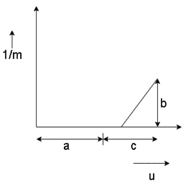Exercise 1
Embibe Experts Physics Solutions for Exercise 1
Simple step-by-step solutions to Exercise 1 questions of Ray Optics from Comprehensive Guide to WBJEE Physics. Other applicable Exams - JEE Main, BITSAT, AMUEEE, MHT-CET, K-CET, EAMCET, VITEEE & Other State Engg. Entrance Exams. Also get 3D topic explainers, cheat sheets, and unlimited doubts solving on EMBIBE.
Questions from Exercise 1 with Hints & Solutions
If the refractive indices of a prism for red, yellow and violet colours be , and respectively, then the dispersive power of the prism will be
Minimum deviation is observed with a prism having angle of prism , angle of deviation , angle of incidence and angle of emergence . We then have generally
The refractive index of a material of a prism of angles is . The path of the ray of light incident normally on the hypotenuse side is shown in the figure.
A students plots a graph between inverse of magnification produced by a convex thin lens and the object distance as shown in figure. What was the focal length of the lens used?

Which of the following is not due to total internal reflection?
A ray of light travelling in a transparent medium of refractive index , falls on a surface separating the medium from air at an angle of incidence of . For which of the following value of the ray can undergo total internal reflection?
Two convex lenses of power and are separated by a distance . The power of optical system formed is
A ray of light is incident at an angle of incidence on one face of a prism of angle (assumed to be small) and emerges normally from the opposite face. If the refractive index of the prism is , the angle of incidence , is nearly equal to
